Algonquin Hotel
Introduction
Text-to-speech Audio
Images
A Vicious Circle by Natalie Ascencios. Left to right: (back) Robert Benchley, Franklin Pierce Adams, Robert Sherwood, Harpo Marx, Alexander Woolcott, Marc Connelly, Edna Ferber, (front) Dorothy Parker, Harold Ross, George S. Kaufman, Heywood Broun
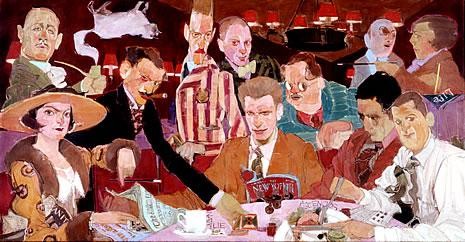
Algonquin Hotel historic marker (image from Historic Markers Database)
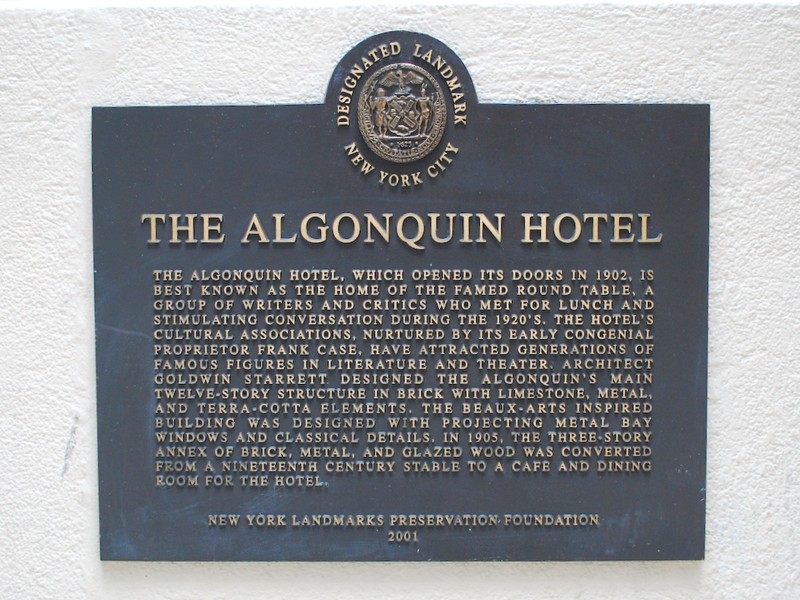
Historic Hotels marker on the Algonquin (image from Historic Markers Database)
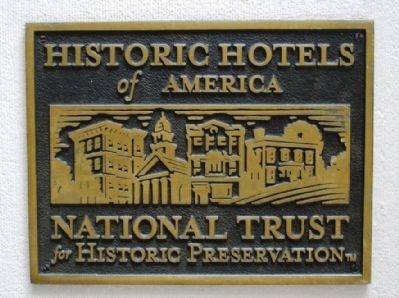
Literary Landmark marker on the Algonquin (image from Dorothy Parker Society)
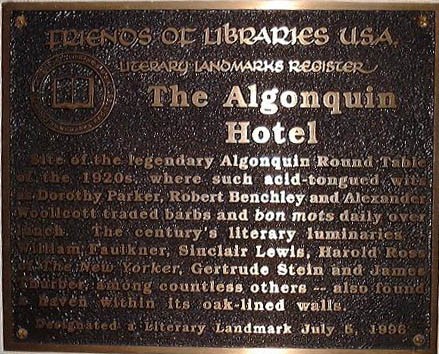
Algonquin Hotel (image from hotels.com)
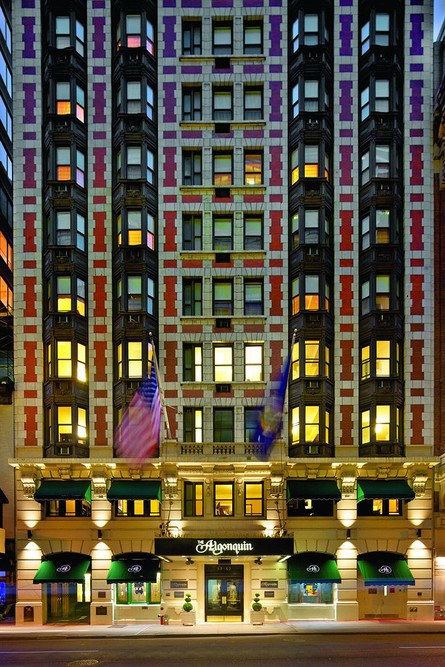
Historic and modern facade of the Algonquin (image from taringa.net)
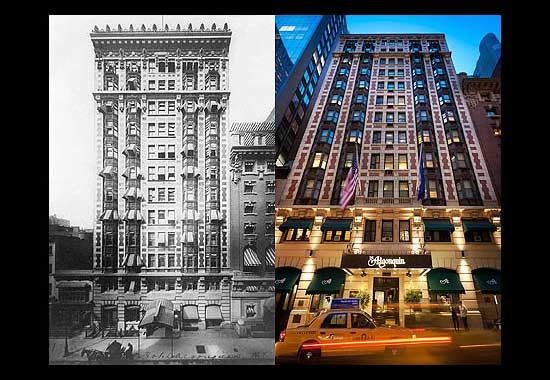
The Blue Bar (image from the Algonquin Hotel official website)
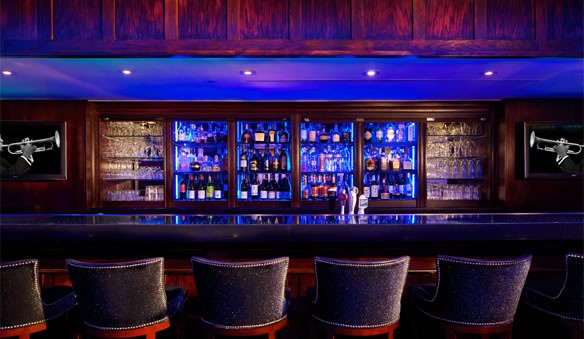
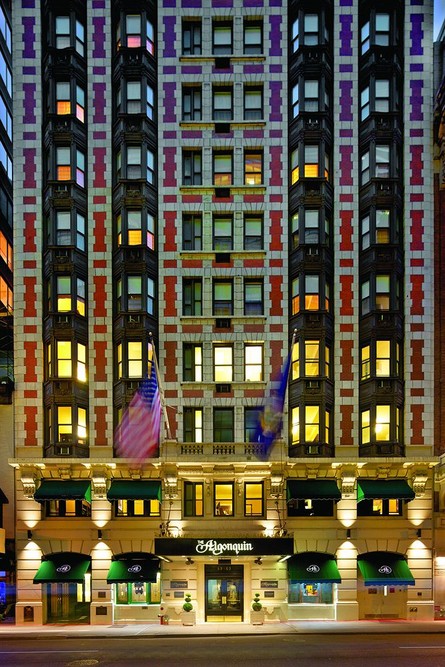
Backstory and Context
Text-to-speech Audio
The hotel was designed by architect Goldin Starrett and his brothers (designer of the Empire State Building, among other famous landmarks). The Renaissance limestone and brick facade is twelve stories tall, with 174 guest rooms. Originally, the hotel was to be named The Puritan, but the first general manager, Frank Case, suggested The Algonquin instead. When the Algonquin opened on November 22, 1902, single rooms rented for two dollars a night, and three-bedroom suites for ten. Two years later, a nineteenth-century, two-story horse stable on the adjoining property was annexed as part of the hotel, and a third floor was added to the annex in 1905. The annex has housed a barber shop, apartments, a supper club, a rehearsal studio, and several restaurants in its time. Thanks to Frank Case, who welcomed theater and literary guests genially, the hotel was frequented by actors, critics, writers, and publishers.
In the summer of 1919, New York Times drama critic Aleck Woollcott returned from World War I. A lunch party was thrown in the Algonquin's Pergola Room (now the Oak Room) by approximately twenty-four of Woollcott's friends, including newspapermen Franklin P. Adams, Heywood Broun, George S. Kaufman, Marc Connelly, and Deems Taylor; actresses Peggy Wood and Margalo Gillmore; magazine writer Margaret Leech; publicists John Peter Toohey and William Murray; and Vanity Fair writers Robert E. Sherwood and Dorothy Parker, along with their managing editor, Robert Benchley. The group returned nearly every day for lunch for the next ten years, outgrowing the Pergola Room and accommodated in the main dining room by Frank Case, who gave them a round table in the Rose Room (now the Round Table Restaurant). According to the Dorothy Parker society, "The 'Vicious Circle' is the most celebrated literary group in American Literature," [3]. In addition to their six-days-a-week, long lunch meetings, the Algonquin Round Table (also known as the Vicious Circle) often met upstairs in the hotel rooms of its members for night-time poker games. At one of these, Harold Ross won enough money to finance and found The New Yorker in 1925.
The Algonquin opened the Blue Bar in 1933, after Prohibition ended. The bar's name comes from its blue lighting, suggested by actor and long-term hotel guest John Barrymore. Barrymore is also responsible for the tradition of naming the hotel's resident male cats Hamlet, though the first cat, who took up residence in 1923, was named Billy. Since Billy's time, the hotel has had seven Hamlets and three Matildas (the name of the current Algonquin cat).
On March 25, 1936, the New York Drama Critics Circle Awards judges met at the Algonquin to vote for a winner. After three days of arguing, a winner was decided, and a dinner reception was held at the hotel to award Maxwell Anderson's Winterset. After Frank Case's death in 1946, Ben Bodne purchased the hotel to fulfill a promise made to his wife, as the couple had fallen in love with the Algonquin during their honeymoon stay in 1924.
The Oak Room opened as a cabaret in 1981, launching the careers of Harry Connick, Jr., Diana Kroll, Michael Feinstein, Peter Cincotti, and Andrea Marcovicci. The Algonquin was designated a New York City Landmark in 1987, though it is not protected from renovation or demolition by the Landmarks Preservation Commission. The Friends of Libraries USA added the hotel to the list of National Literary Landmarks in 1996. Renovations to the hotel beginning in 1998 included the restoration of the lobby to its pre-war appearance, modernization of amenities, and the installation of a new round table. The hotel closed for the first time in its 102-year history for renovations in the summer of 2004 for the addition of two special events rooms and 3,000 square feet of meeting room space on the second floor. The upstairs hallways are decorated with New Yorker cartoon wallpaper, and the Library Boardroom includes the hotel's permanent book collection. The multi-million dollar renovations were designed by Alexandra Champalimaud.
Marker inscriptions:
[Historic Marker]
The Algonquin Hotel, which opened its doors in 1902, is best known as the home of the famed Round Table, a group of writers and critics who met for lunch and stimulating conversation during the 1920s. The hotel's cultural associations, nurtured by its early congenial proprietor Frank Case, have attracted generations of famous figures in literature and theater. Architect Goldwin Starrett designed the Algonquin's main twelve-story structure in brick with limestone, metal, and terra-cotta elements. The Beaux-Arts inspired building was designed with projecting metal bay windows and classical details. In 1905, the three-story annex of brick, metal, and glazed wood was converted from a nineteenth century stable to a cafe and dining room for the hotel.
[Historic Hotels Marker]
Historic Hotels of America
National Trust for Historic Preservation TM
[Literary Landmarks Marker]
Friends of Libraries USA
Literary Landmarks Register
The Algonquin Hotel
Site of the legendary Algonquin Round Table of the 1920s, where such acid-tongued wits as Dorothy Parker, Robert Benchley and Alexander Woollcott traded barbs and bon mots daily over lunch. The centuries literary luminaries William Faulkner, Sinclair Lewis, Harold Ross of The New Yorker, Gertrude Stein and James Thurber among countless others -- also found a haven within its oak-lined walls.
Designated a Literary Landmark July 6, 1996
Cite This Entry
Thagard, Gavin, Sara Marian, and Clio Admin. "Algonquin Hotel." Clio: Your Guide to History. May 2, 2021. Accessed March 18, 2025. https://theclio.com/entry/21925
Sources
"A Glimpse Into the Hotel." The Algonquin Hotel. Accessed Web, 5/11/17. http://www.algonquinhotel.com/story/the-hotel/.
"Algonquin Hotel." The Historical Marker Database. Accessed Web, 5/11/17. http://www.hmdb.org/marker.asp?marker=7968.
"The Algonquin Hotel." The Dorothy Parker Society. Accessed Web, 5/11/17. http://www.dorothyparker.com/wordpress/dorothy-parker-haunts/the-algonquin-hotel.

